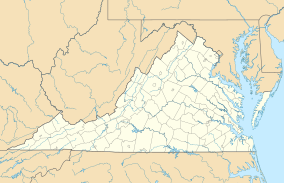Cumberland Gap National Historical Park
| Cumberland Gap National Historical Park | |
|---|---|
|
IUCN category V (protected landscape/seascape)
|
|

Fog forming over the gap.
|
|
| Location | Kentucky, Tennessee, and Virginia, United States |
| Nearest city | Middlesboro, Kentucky |
| Coordinates | 36°36′15″N 83°41′14″W / 36.60417°N 83.68722°WCoordinates: 36°36′15″N 83°41′14″W / 36.60417°N 83.68722°W |
| Area | 20,508 acres (82.99 km2) |
| Established | June 11, 1940 |
| Visitors | 853,998 (in 2012) |
| Governing body | National Park Service |
| Website | Cumberland Gap National Historical Park |
Established on June 11, 1940, Cumberland Gap National Historical Park is a United States National Historical Park located at the border between Kentucky, Tennessee, and Virginia. The Cumberland Gap is a sizable natural break in the Appalachian Mountains.
The park lies in parts of Bell and Harlan counties in Kentucky, Claiborne County in Tennessee, and Lee County in Virginia. The park contains the Kentucky-Virginia-Tennessee tri-state area, accessible via a short trail.
Cumberland Gap National Historical Park covers 20,508 acres (8,299 ha), and saw 853,998 visitors in 2012.
The Cumberland Gap Visitor Center is located on U.S. Highway 25E just southeast of Middlesboro, Kentucky and just northwest of the Cumberland Gap Tunnel and Cumberland Gap, Tennessee. The visitor center features a museum with interactive exhibits about the Gap's role as a transportation corridor, an auditorium that shows films about the area's cultural and natural history, a book store and the Cumberland Crafts gift shop with crafts from Appalachia. The visitor center is open each day of the year except Christmas Day.
The gap was long used by Native Americans, as many species of migratory animals passed through it from north to south each year. It was fertile hunting territory and the only easy cut through the mountains from the southern wintering grounds of wild deer and buffalo to their northern summer range. Starting around 1775, the Gap became the primary route of transit for American settlers moving west into Kentucky; between 1775 and 1810 as many as 300,000 settlers may have used the Gap.
...
Wikipedia


